With all their wealth, breaking into the first team at Manchester City represents a daunting task for the youngsters in their Elite development squad. Wonderkid Jadon Sancho left to join Borussia Dortmund in 2017, with the likes of Leroy Sané and Raheem Sterling standing between him and playing opportunities at the Etihad. Meanwhile, Phil Foden continues to be drip-fed minutes with the senior side, despite being recognised as one of the most gifted teenagers in the game.
Another talent hoping to overcome the odds by securing his place in Pep Guardiola‘s plans is central defender Eric García. Seen by many as a long term replacement for Sky Blues legend Vincent Kompany, García has been earning rave reviews from his manager in recent months. This analysis will attempt to shine a light on the attributes that mark him out as one of the most promising defenders in European football.
Story so far
Having joined Barcelona in 2008, Eric García spent nine years at La Masia before moving to Manchester City at the age of 16. The youngster settled quickly in the North-West of England, captaining the under 18’s, as well as impressing for the under 19’s in their UEFA Youth League campaign.
The young Citizens were knocked out of the competition by García’s old teammates from Barca in the semi-finals. However, his reputation was continuing to grow, with Pep Guardiola selecting him in the first team squad for their pre-season tour of the USA.
A couple of months later, Pep recalled the rookie’s performances in the states:
“In pre-season he was incredible, commanding the line against Bayern Munich and Liverpool.”
At the beginning of this season, García had to fight his way through a spell on the sidelines, before returning to action in November. A month later, he was thrown into League Cup action against Leicester City at the King Power Stadium. He handled the occasion well and went on to start both legs of their semi-final with Burton Albion.
Ball-playing defender
García is extremely competent in possession. His passing range and selection are excellent, with an impressive ability to break the opponent’s defensive lines with quick and accurate passes.
His close control is also apparent, helping him to carry the play forward before releasing possession to a teammate on the last line of the attack. This multi-dimensional aspect to his game allows him to find ways to progress against the different conditions set by the opposition.
Not only does García have the technical assets to excel in possession, he also has the intelligence. He consistently makes good use of the ball in his attempts to shift the opponents and create gaps to play through. He also understands how to create better opportunities for his teammates by drawing pressure from opposing players and creating space behind them in the process.
In the sequence shown below, García recognises the opportunity to carry the ball further into midfield. In this situation, some defenders might look to play a diagonal cross-field ball to the winger on the far side. However, Burton Albion’s left-back and left-midfielder have good access to the wide man.
With this in mind, a lofted pass between them would have a fair chance of being cut out, making it a weak option for García. Instead of playing the early out-ball, he dribbles into the centre, drawing pressure from the opponents and altering the positional layout.
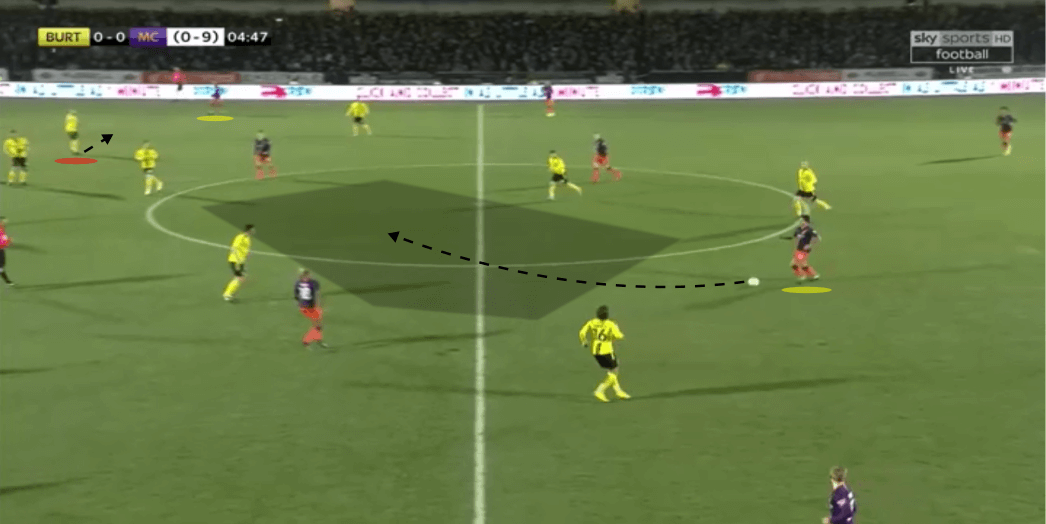
The left-back on the far side has tucked in somewhat, with three Burton midfielders moving to close down the immediate threat of the dribbler. The winger on the far side now has more space to receive, and the pass distance has been reduced, giving the opponents less chance to intercept. García makes an accurate pass out to the winger having drawn the opposition into the centre.
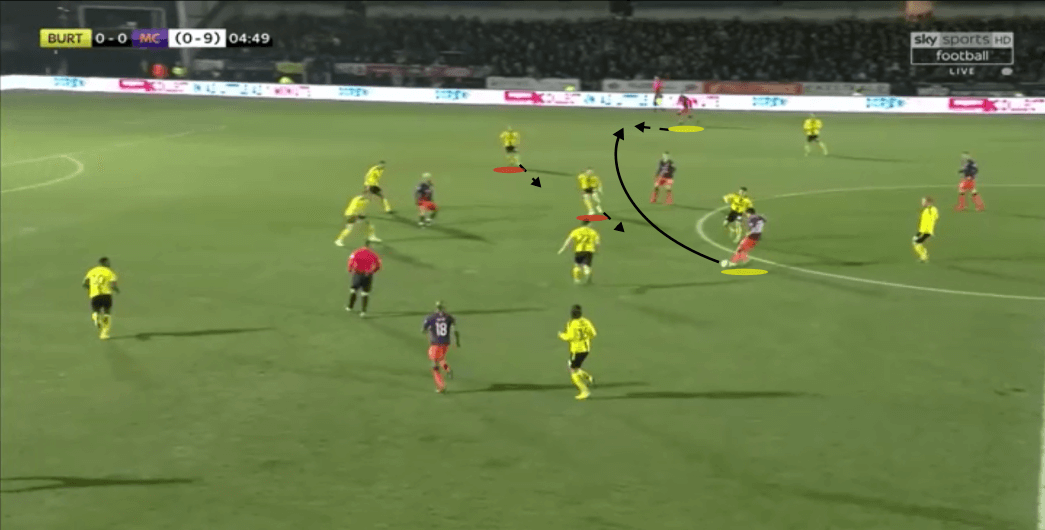
While many of his passes resemble the one above in that they involve feeding the wide players in space, García also has the capacity to penetrate defensive lines centrally. The image below shows him cutting through Burton’s staggered midfield organisation with an incisive pass to the feet of withdrawn striker Gabriel Jesus.
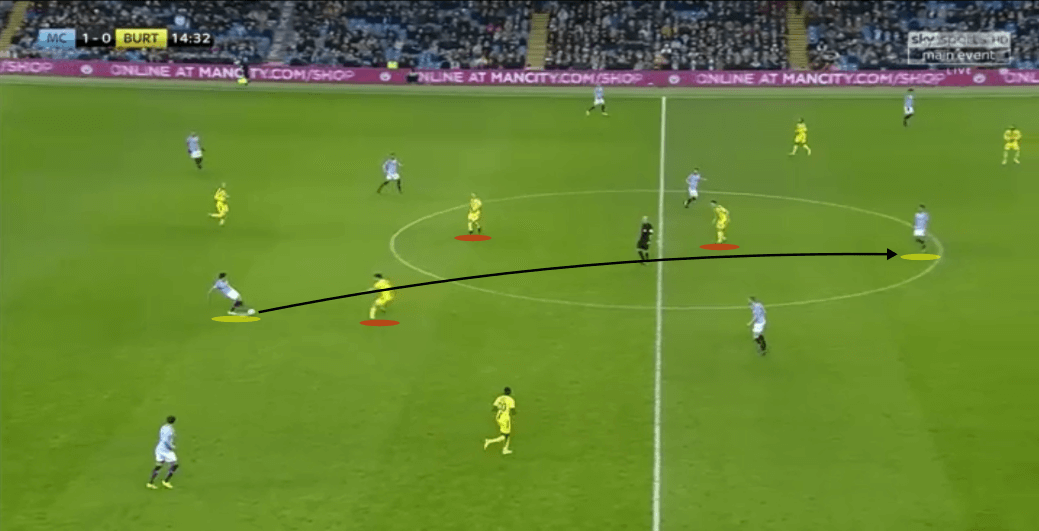
Overall, García’s range of passing and ability to cut through the opponent’s lines are both of an exceptional level. Pep has commented on this area of his game in recent months, noting his ability to identify passing lanes after the game against Leicester City.
“He has good vision, a good pass. It’s incredible, I’m very pleased. He didn’t make one mistake and with the ball, he played with huge personality.”
His stats back this up, with a pass accuracy of 92%. He also makes an average of 8.98 passes to the final third, 74% of which find their intended target.
Positional sense
The intelligence García shows in possession is also reflected out of possession. He reads the game well, making composed decisions under pressure. Playing for Manchester City, he will rarely find himself defending deep with large numbers in support and little amounts of space to cover.
Therefore, quick thinking is crucial to allow him to manage the opponent’s offensive transitions. Often he will be required to do ‘two jobs at once’. Blocking off a pass to one attacker while retaining access to another. García has displayed an ability to position himself appropriately in these kinds of situations.
The image below shows him preventing a quality chance for former City striker Kelechi Iheanacho. After Leicester broke away at pace through Demarai Gray down the left, Kyle Walker and Nicolás Otamendi go out to stop the cross.
García covers the centre, positioning himself between the ball and Iheanacho to head clear the delivery from out wide. It was a superb piece of last-ditch defending and displayed a great positional sense in intense circumstances. Guardiola has been eager to praise this aspect of his game.
“He’s a guy that has a lot of sense of the position.”
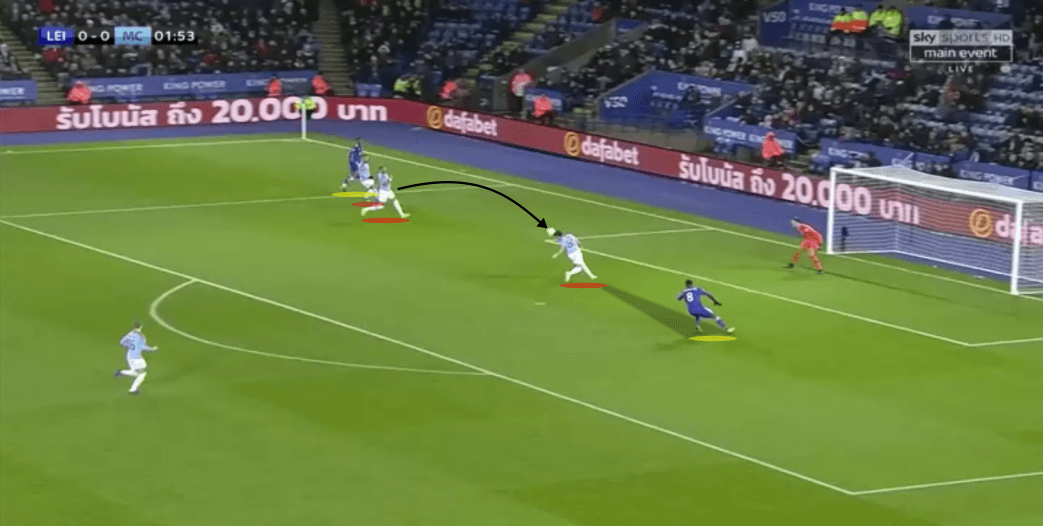
The image above highlights his talent for assessing the surroundings before positioning himself accordingly to cope with the danger. This is a prevalent feature of his game. He makes an impressive 4.78 interceptions per game.
As mentioned, he is usually required to defend depth and hold a high defensive line. As we will see in the next section, this is something he is comfortable and competent at doing. However, with any team, there will be moments in a game where the opponents have managed to progress high up the pitch and establish an attack.
García is adept at positioning himself appropriately in these types of scenarios, and also displays an ability to organise those around him. In the image below, Burton have the ball in an advanced area on the right flank. Moments prior to this scene, the ball had been with City’s hosts just in front of the penalty box. García was engaged by an attacker, getting tight to force him into a backwards pass.
The ball then made it’s way out wide, triggering García to drop back and position himself to protect the front post. He retains sight of the attacker at the same time, not letting him get on his blind-side. The cross is delivered, and the young centre-back is on-hand to clear the threat.
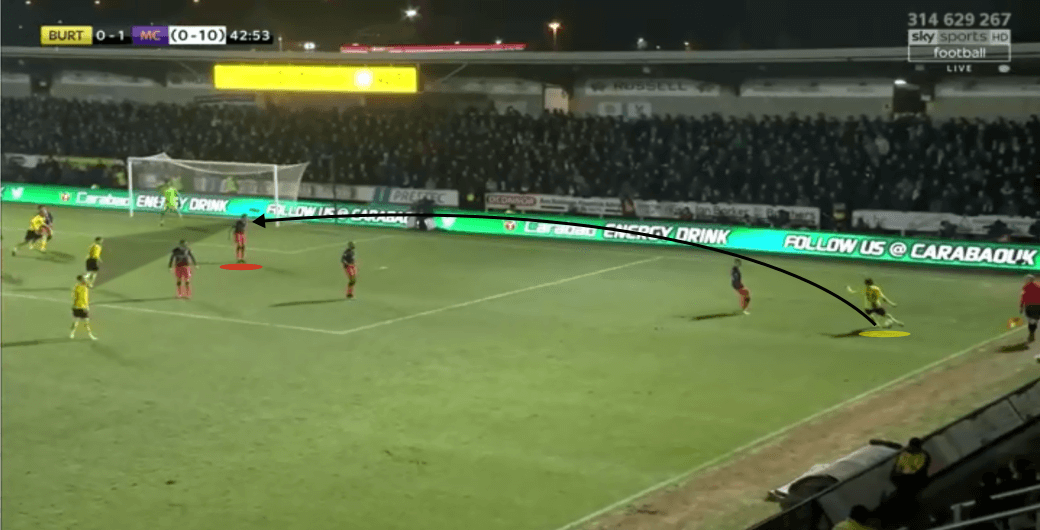
Overall, García consistently shows a talent for quality positioning and decision making without the ball, just as he does with it. This level of defensive nous is rare for a player so young. Guardiola spoke about his maturity following their pre-season encounter with Dortmund last July.
“He is 17 or 18 and played like he is 24 or 25.”
This won’t come as a surprise to anyone who has followed his development in recent years. A feature of his youth career was to regularly play with older age groups. This appears to have helped him with regards to improving positional sense and speed of thought, given that competing on a physical level was often impossible.
1v1’s & defending depth
Given Manchester City’s game model, García is expected to develop into a player who can defend large amounts of space behind him. In Pep’s own words, the Blues ‘like to attack width and defend depth’.
García is intelligent enough to do so, having a good understanding of when to drop and when to push off the back-line. His positioning behind possession to protect against counter-attacks is also notable. Guardiola spoke about how the youngster overcomes any potential physical deficiencies with sharpness of mind.
“He’s so smart and he’s not the strongest in the air or the fastest one but few times the opposition win one position, he’s able to guide the line and has a lot of personality to play.”
In the image below, we see City’s opponents play a long ball into the left channel for their striker to chase. García gets a head-start on his man, knowing that he can’t compete for pace. He then looks to shut off the possibility for the attacker to move infield towards goal.
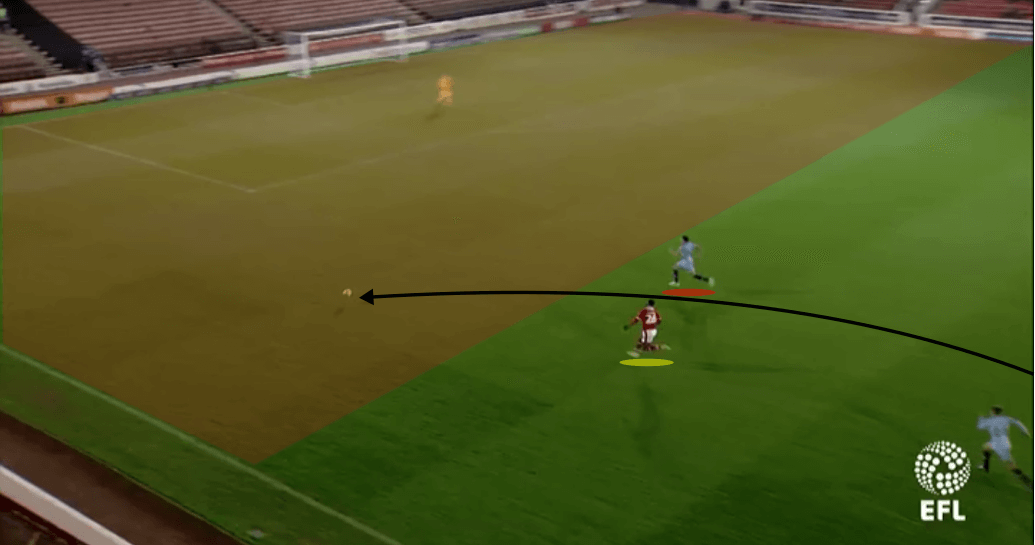
He achieves this with his angle of approach, guiding the Barnsley player towards the touchline and getting tight to him from behind. García ultimately wins the ball, nudging it out of play for a throw-in before organising his defence.
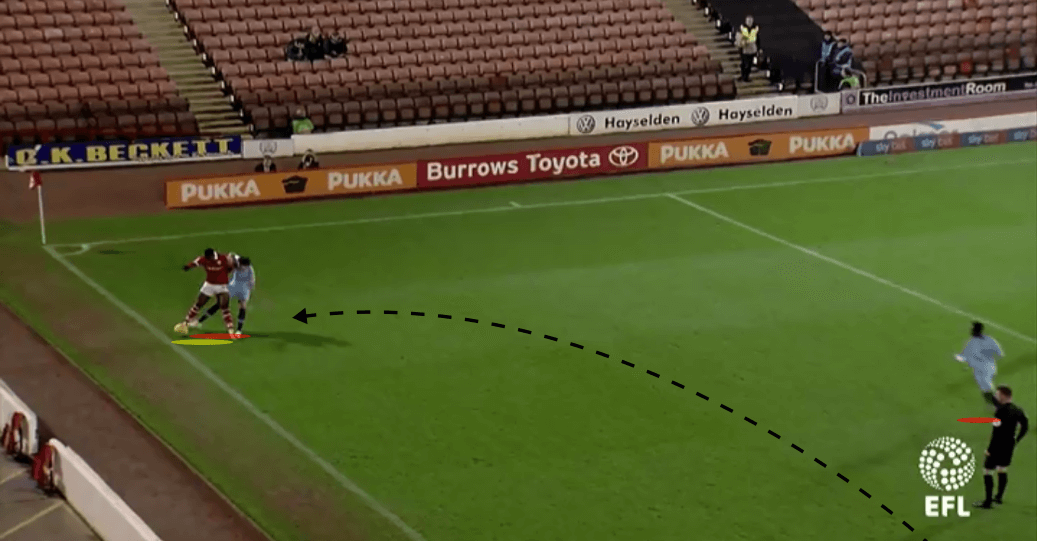
Although he normally succeeds in dealing with these situations, there are some occasions where his approach is slightly off, allowing an attacker to take the ball past him. This issue mainly occurs whenever García finds himself in 1v1’s in his left channel, perhaps due to needing to make challenges on his weaker side.
The images below illustrate this, with García leaving too big an angle on the outside for the attacker to bypass him. Sometimes with young defenders, their body orientation when approaching attackers in wide areas will be marginally off, providing just enough room for the opponent to get around them. However, many of them have the pace to recover with a sliding challenge. Aaron Wan-Bissaka at Crystal Palace is a good example of this.
With García, however, his angle and timing of approach have to be spot on if he is to cope with these scenarios.
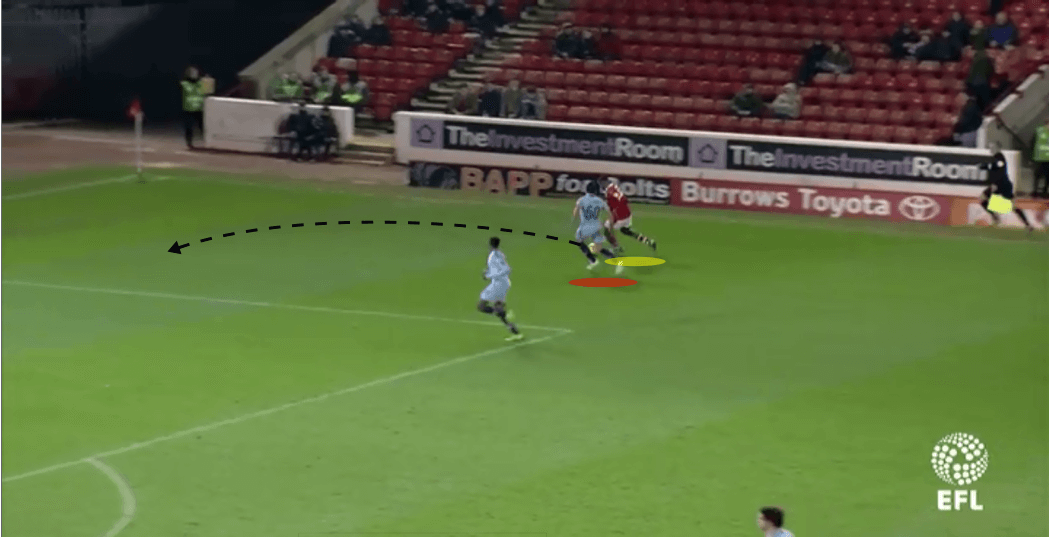
Given his superior pace, the winger glides past García before delivering a cross to the box. Notice how a second City player is drawn out of the centre to help cover for the young defender, leaving more space at the near post.
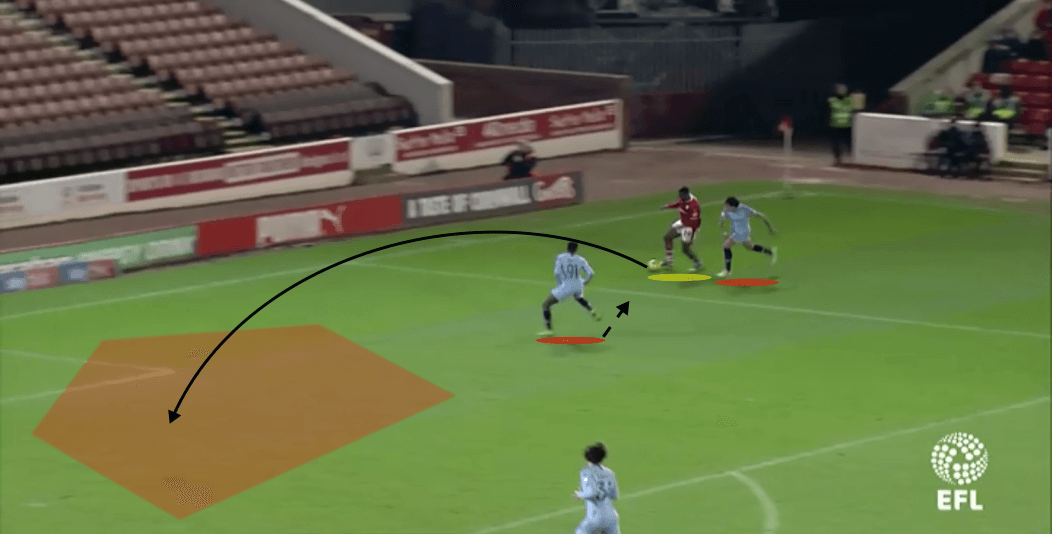
Overall, García is impressive in his defensive actions, often dealing well with 1v1’s and long passes in behind. He is also excellent at stepping out of defence to get tight to an attacker that has dropped off the front.
If there is a weakness to his game, it is coping with 1v1’s on the left, where his defending can be slightly off balance. As mentioned, García doesn’t have the pace or strength to cope with these situations by any other means than intelligent positioning and approach play. His record in defensive duels isn’t great, winning just 28% of his 5.74 per game.
At 6ft, he is the same height as Nicolás Otamendi and isn’t particularly strong from an aerial perspective. The nature of City’s game, however, means that this shouldn’t provide too big a problem.
Conclusion
At just 18 years of age, Eric García has plenty of time to grow as a player and deliver on his obvious potential. With a coach like Pep Guardiola to develop under and players like Aymeric Laporte to learn from, the Spanish youngster has every chance of becoming one of the games’ elite ball-playing defenders in the coming years.
The opportunity to shine on a weekly basis may be a few seasons away yet. However, much like his teammate Phil Foden, perhaps a gradual introduction will serve García well in the long run.
If you love tactical analysis, then you’ll love the digital magazines from totalfootballanalysis.com – a guaranteed 100+ pages of pure tactical analysis covering topics from the Premier League, Serie A, La Liga, Bundesliga and many, many more. Buy your copy of the April issue for just ₤4.99 here, or even better sign up for a ₤50 annual membership (12 monthly issues plus the annual review) right here.

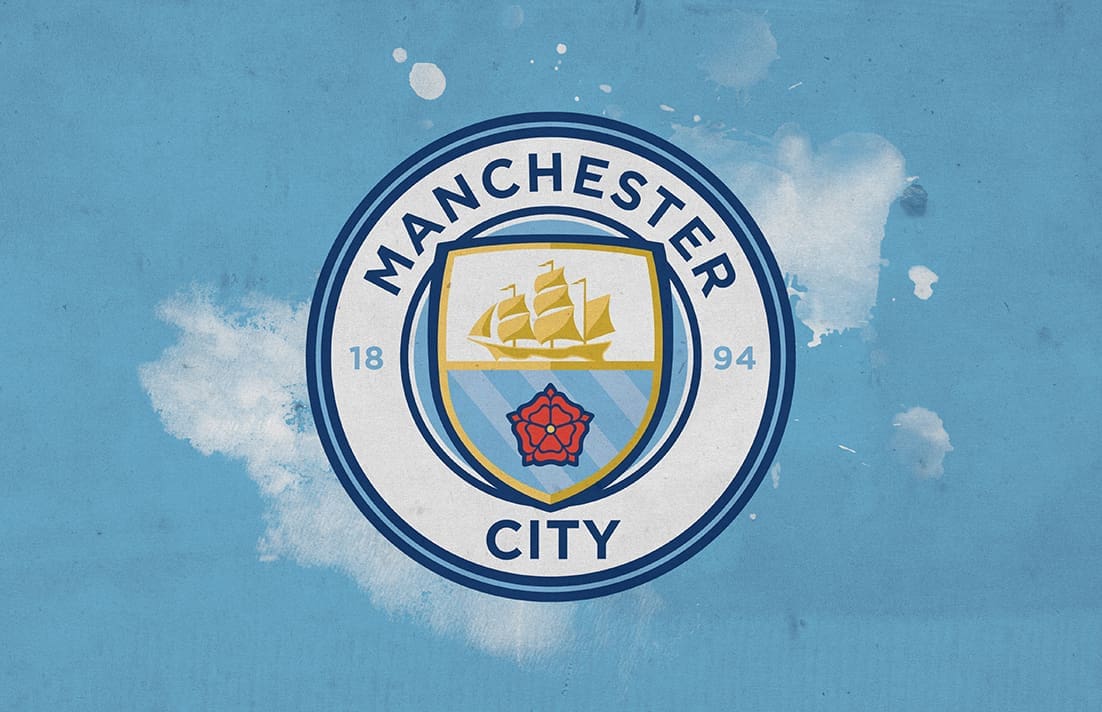



Comments